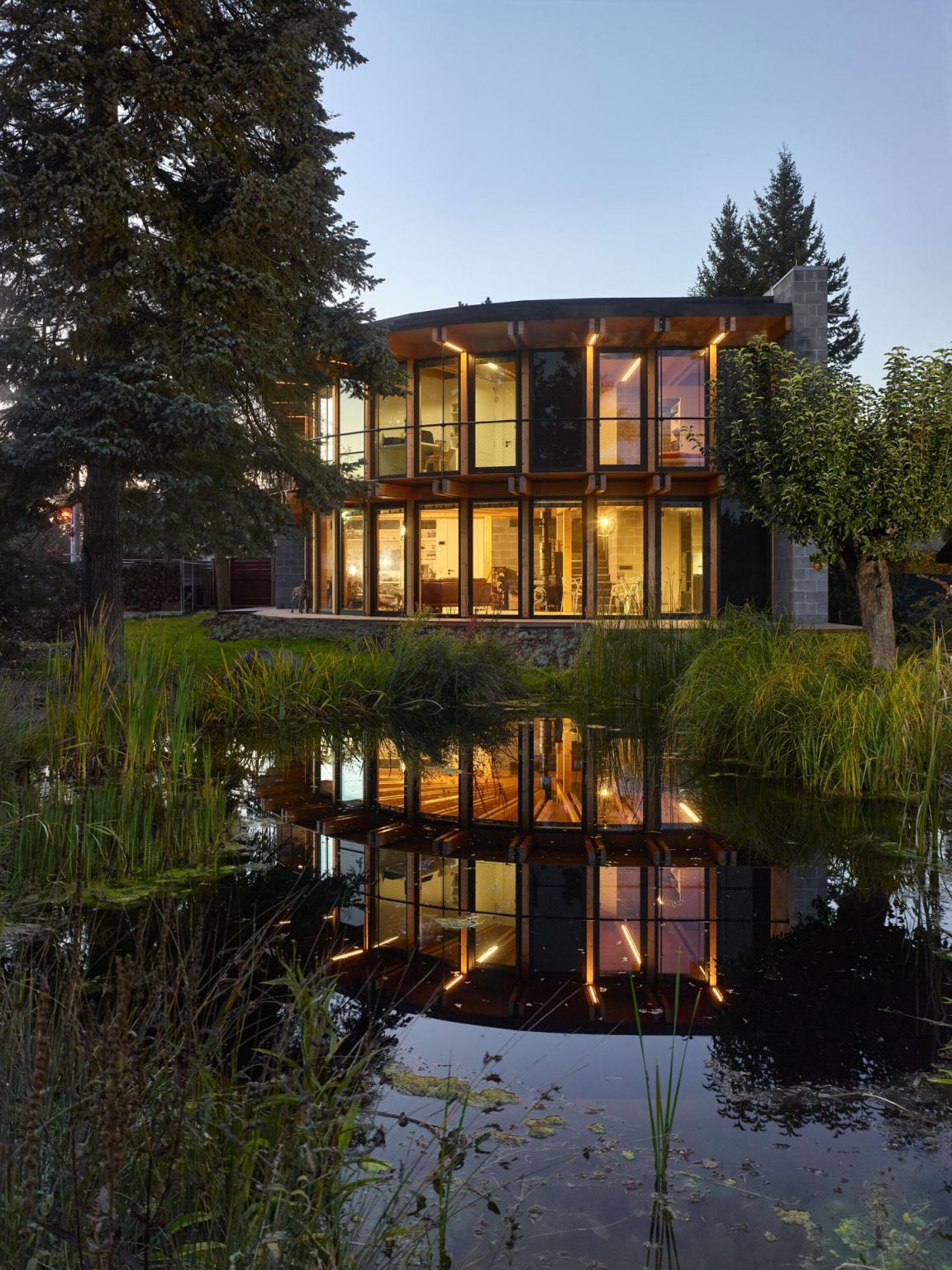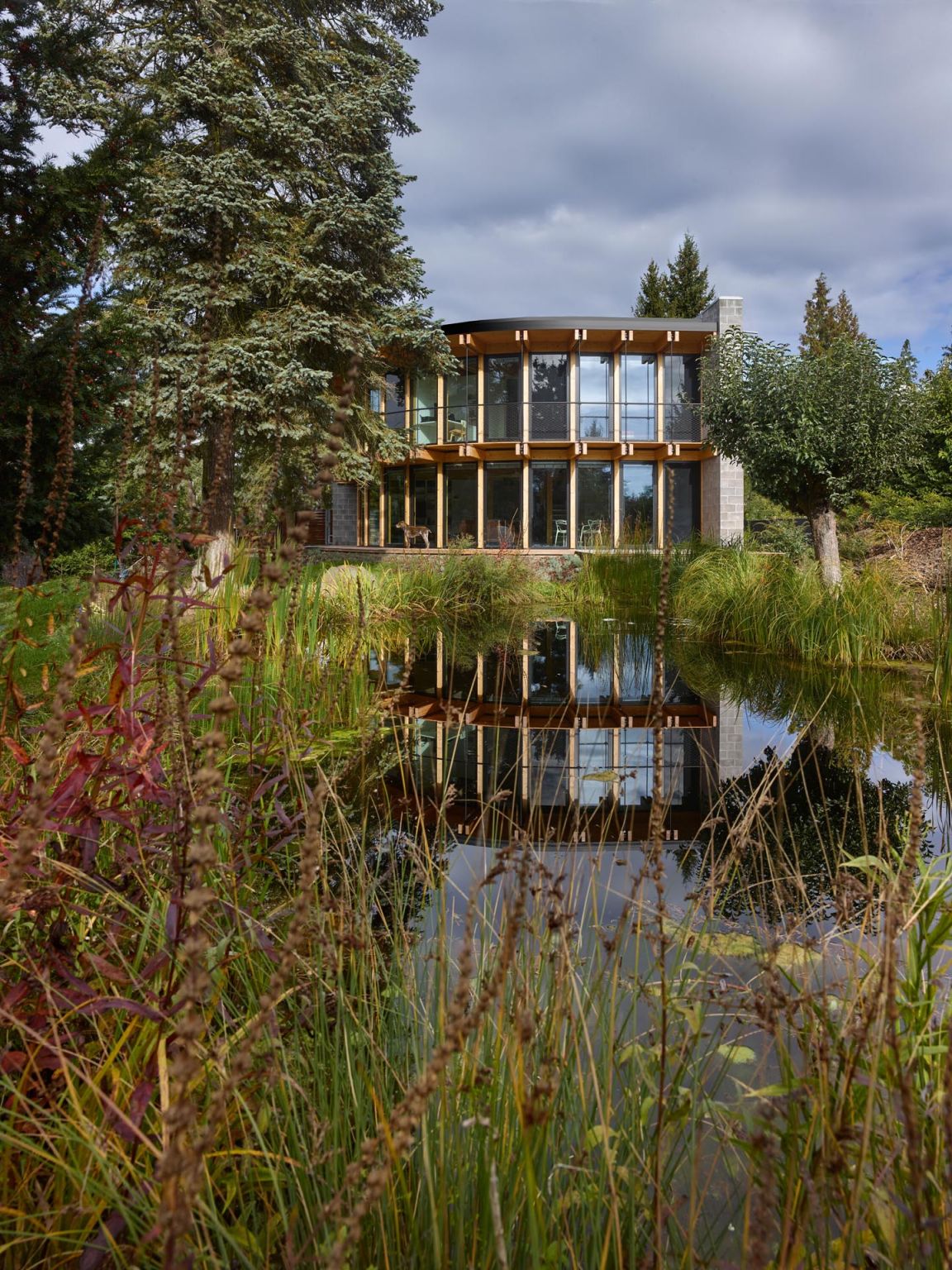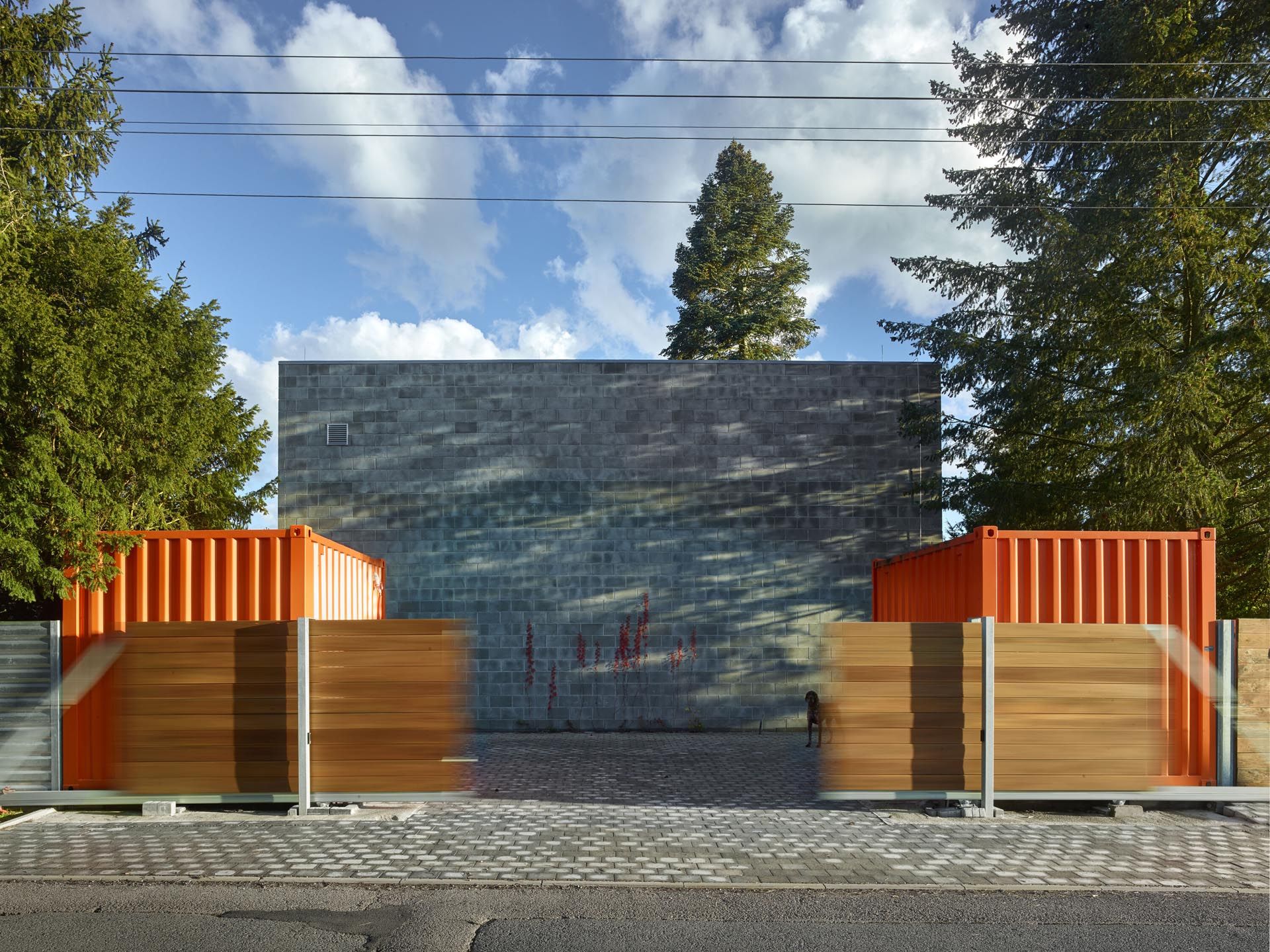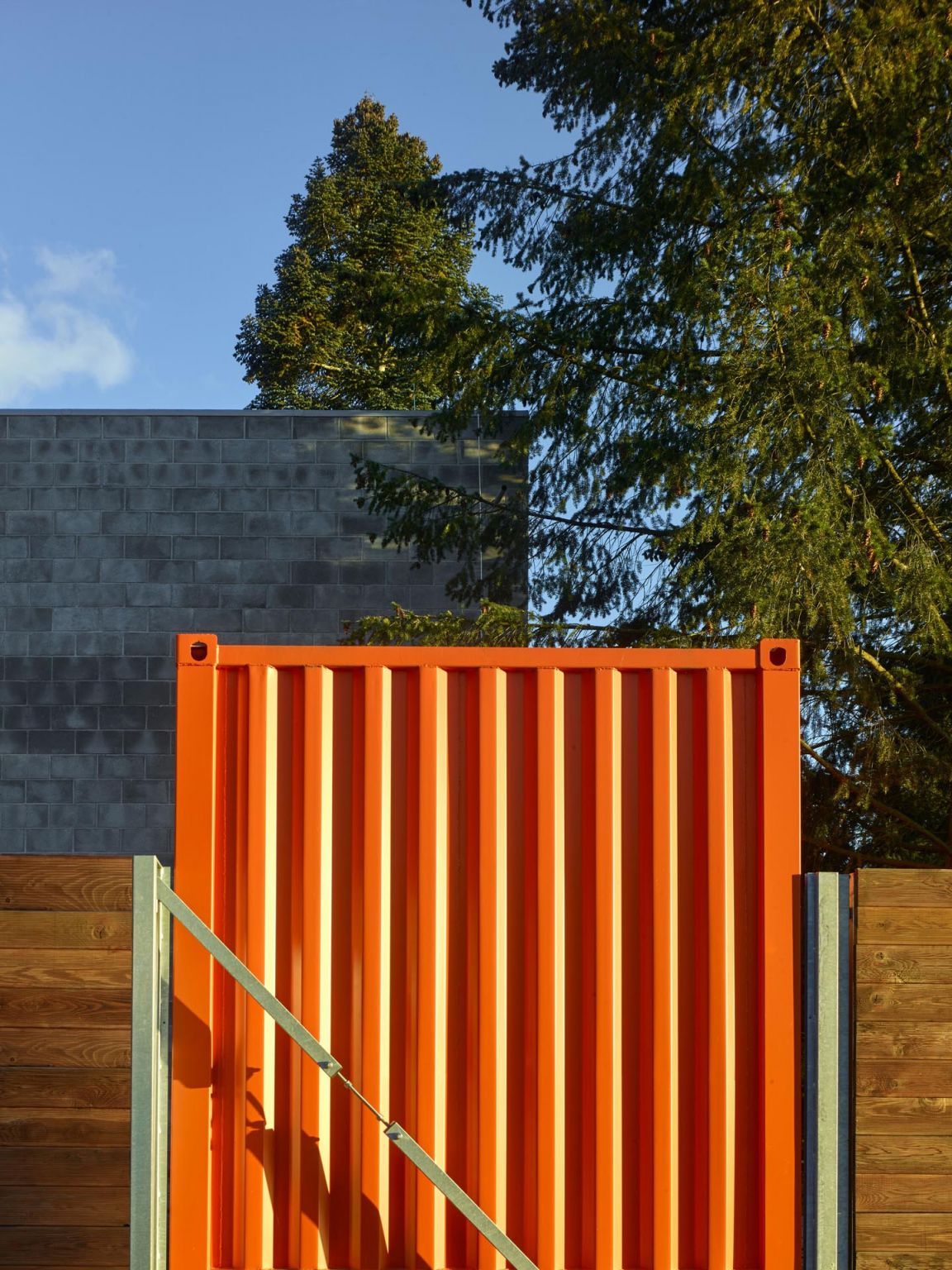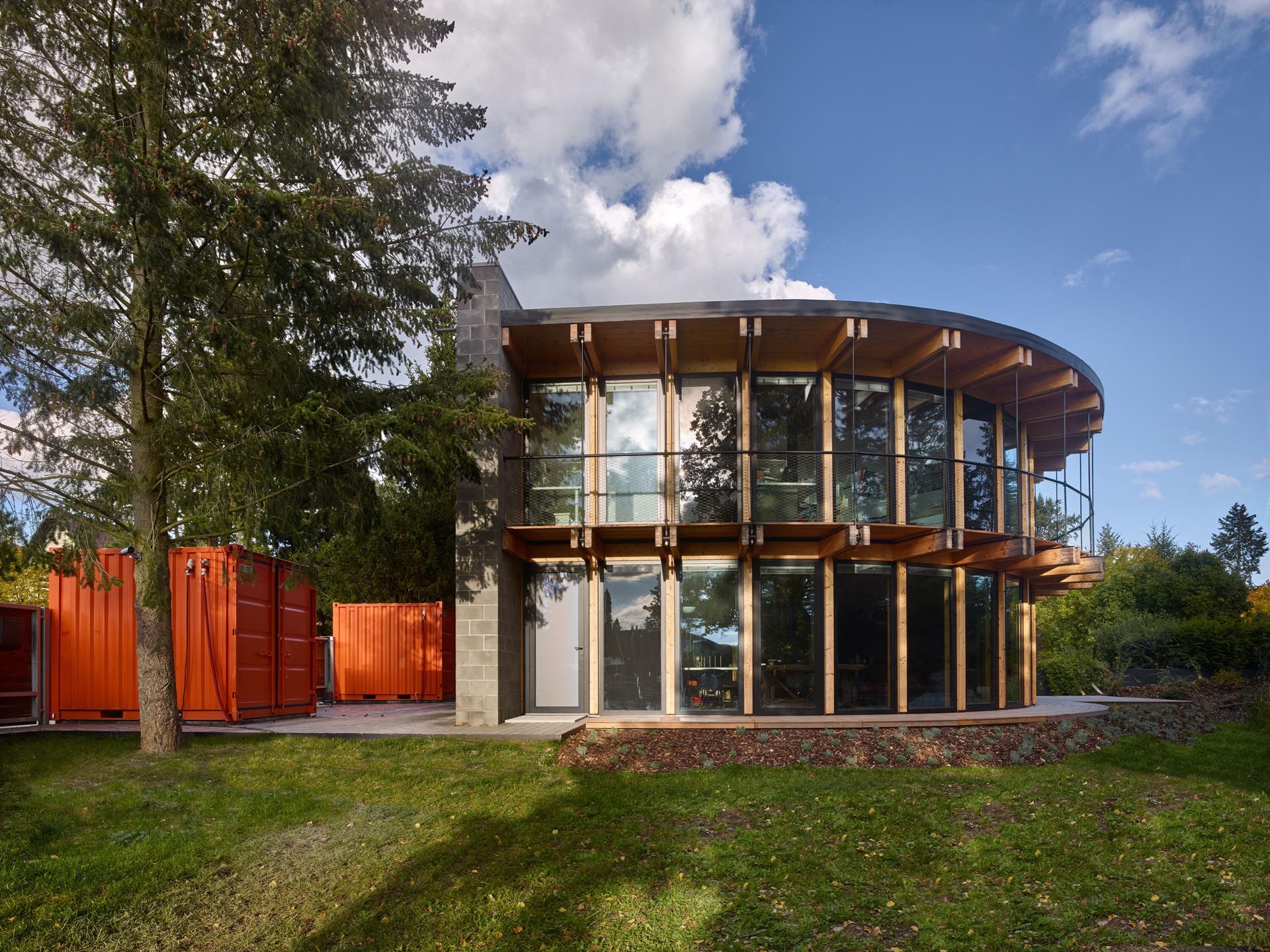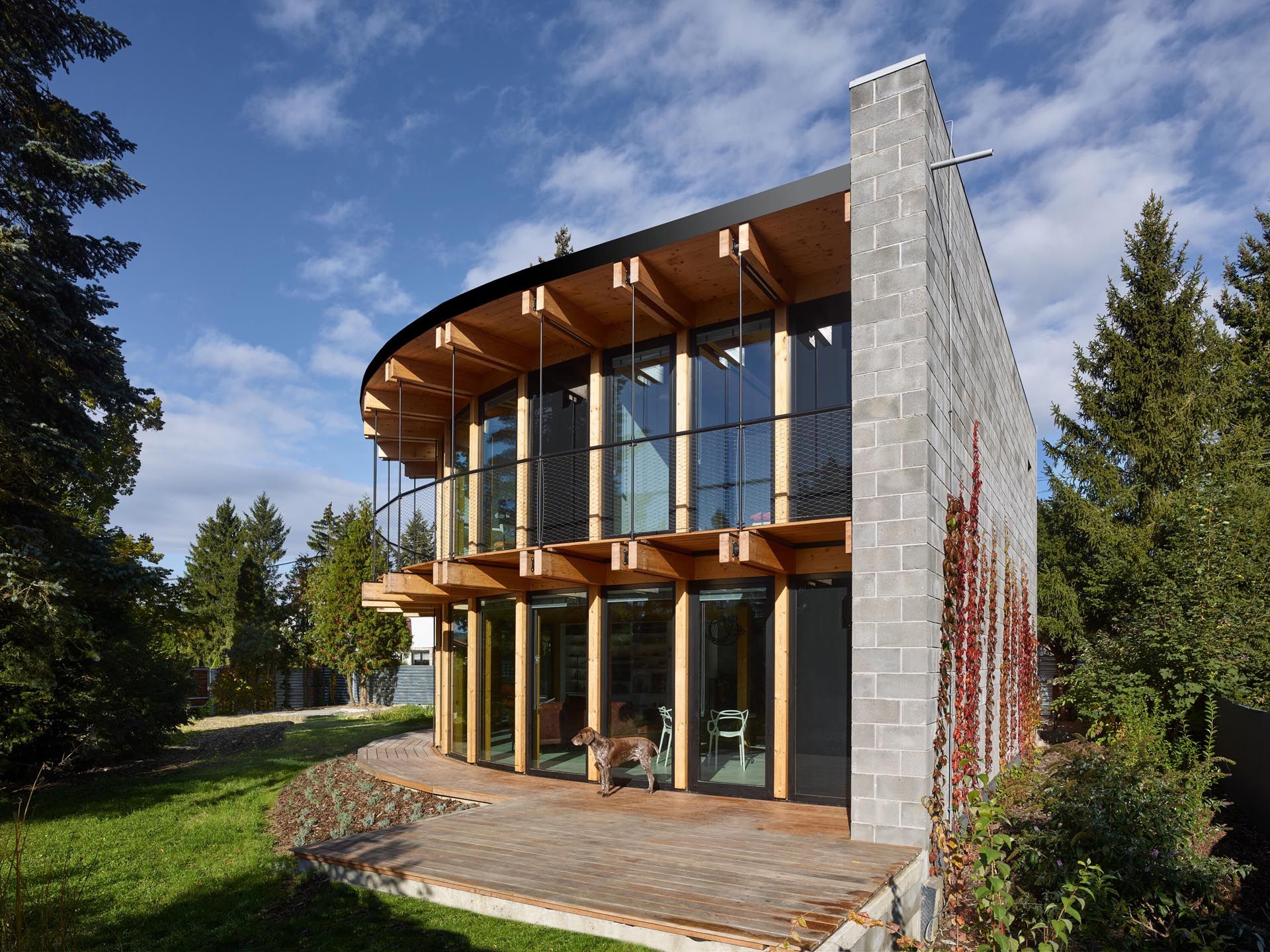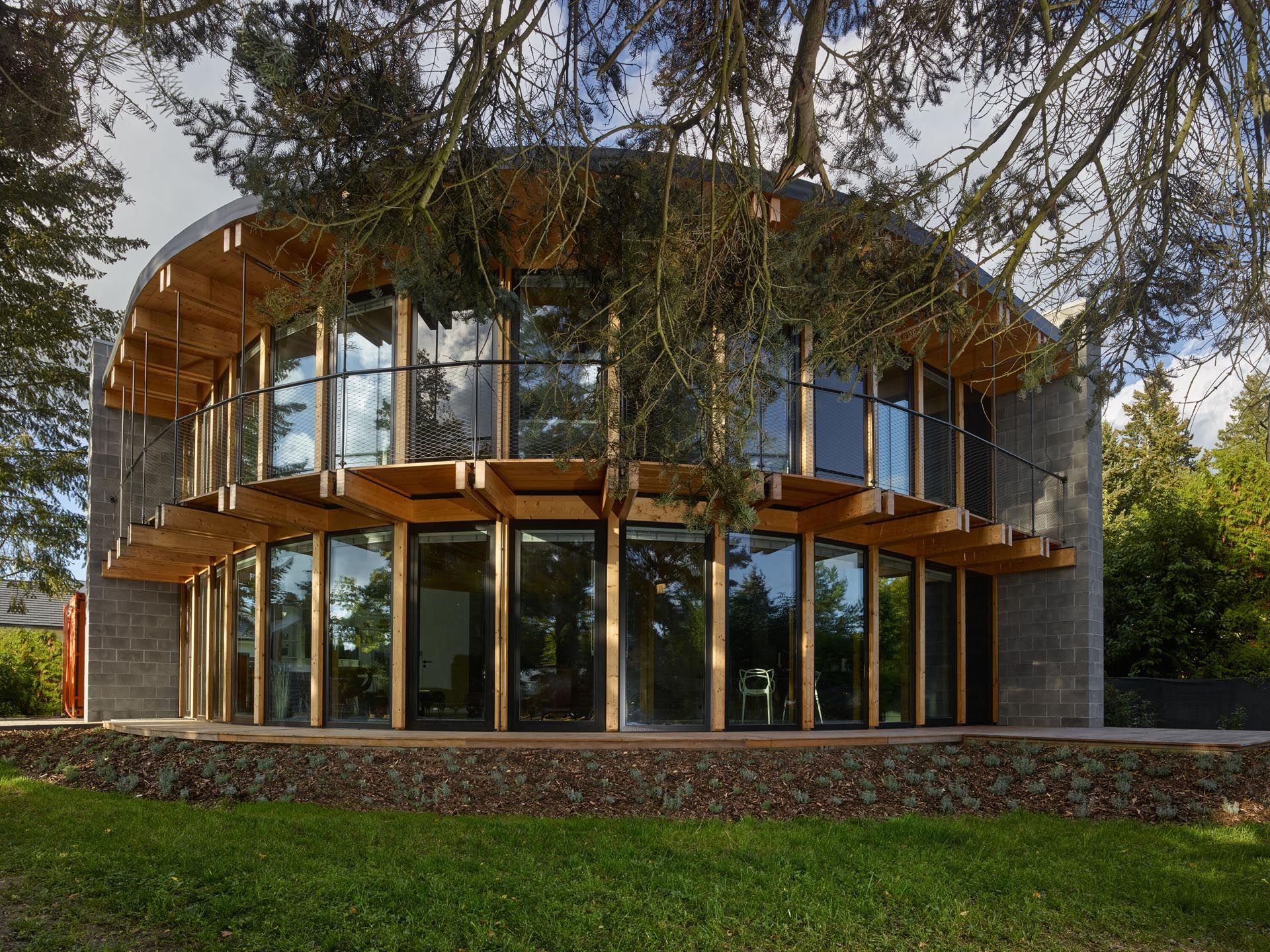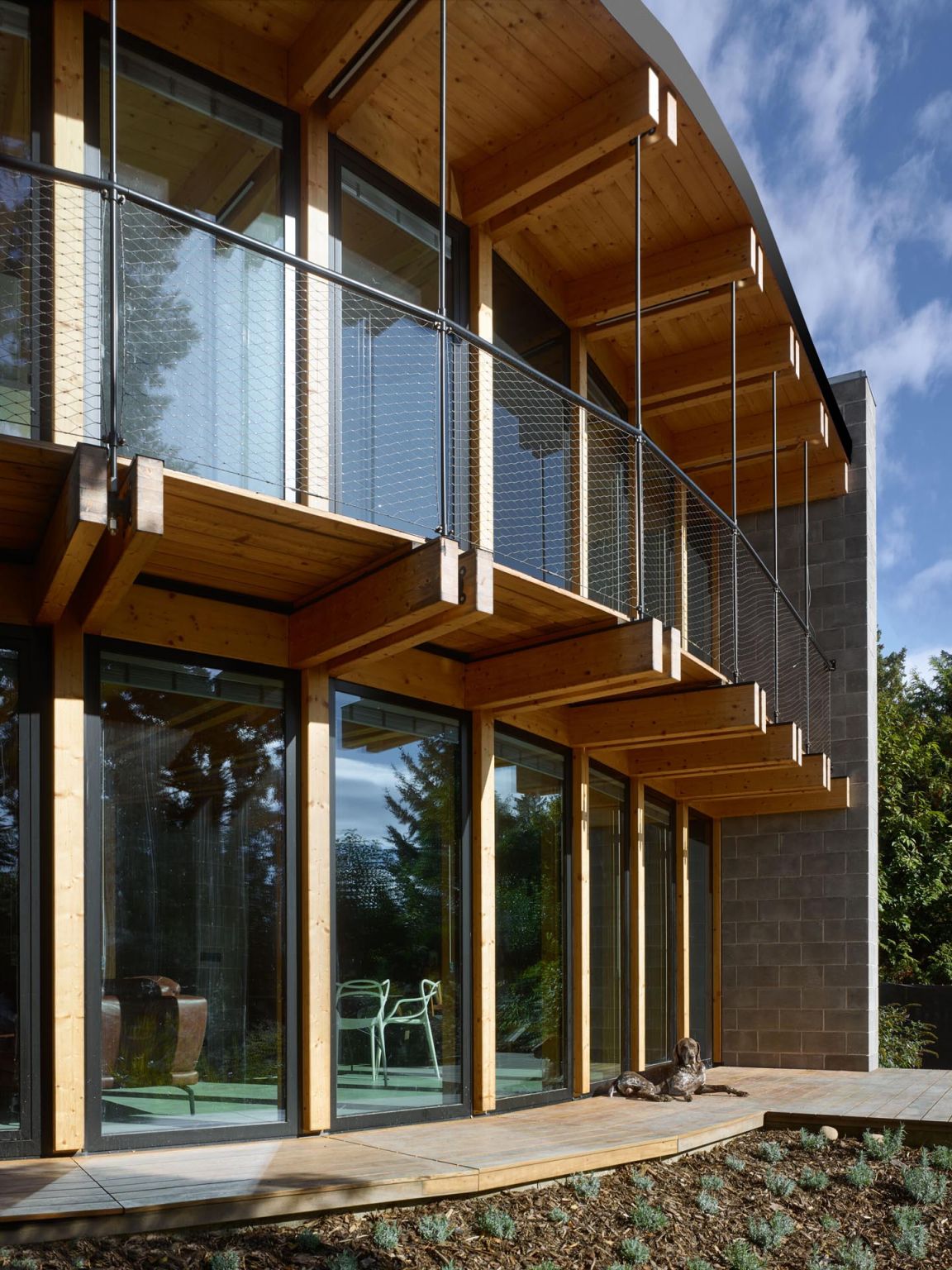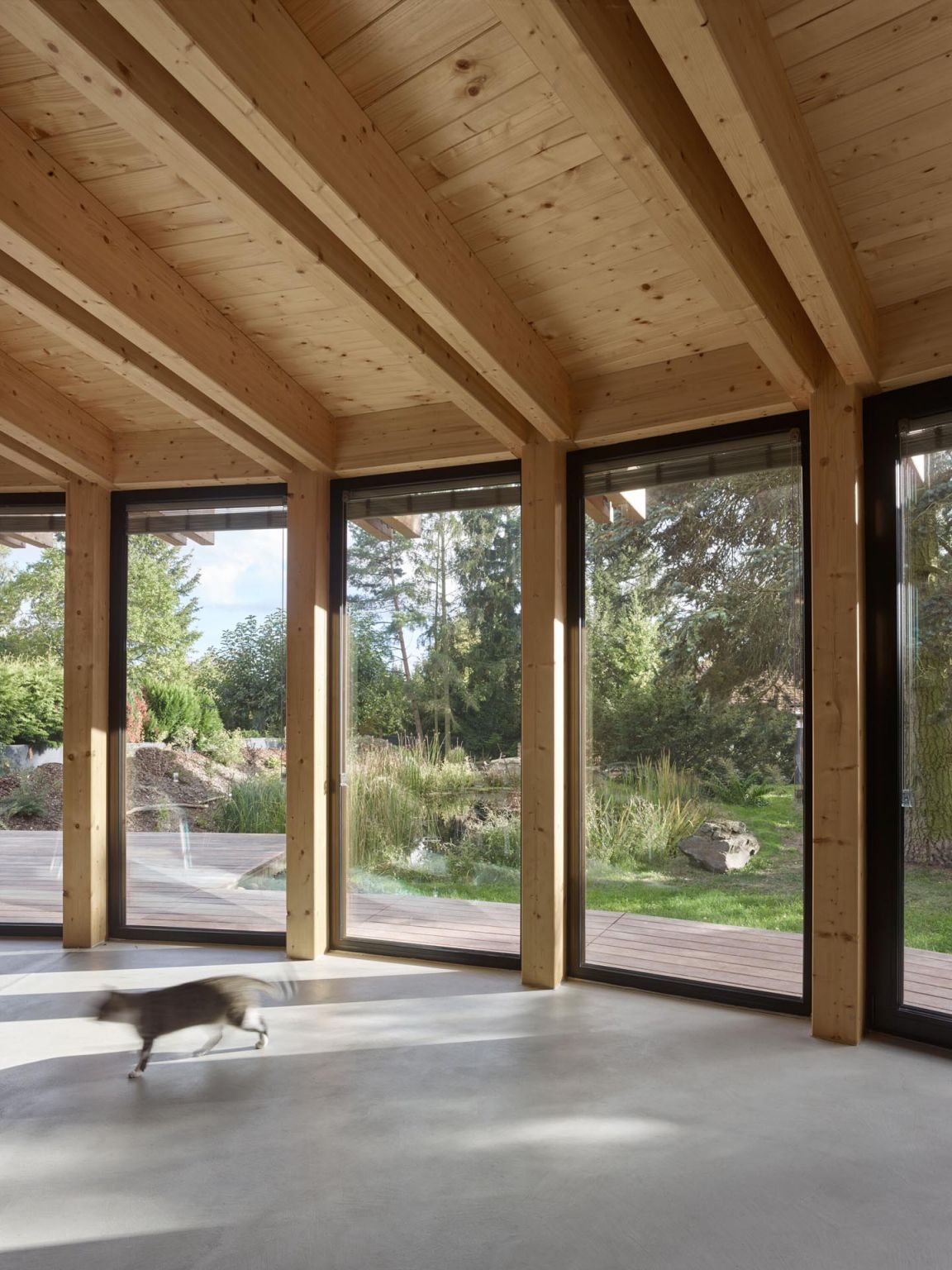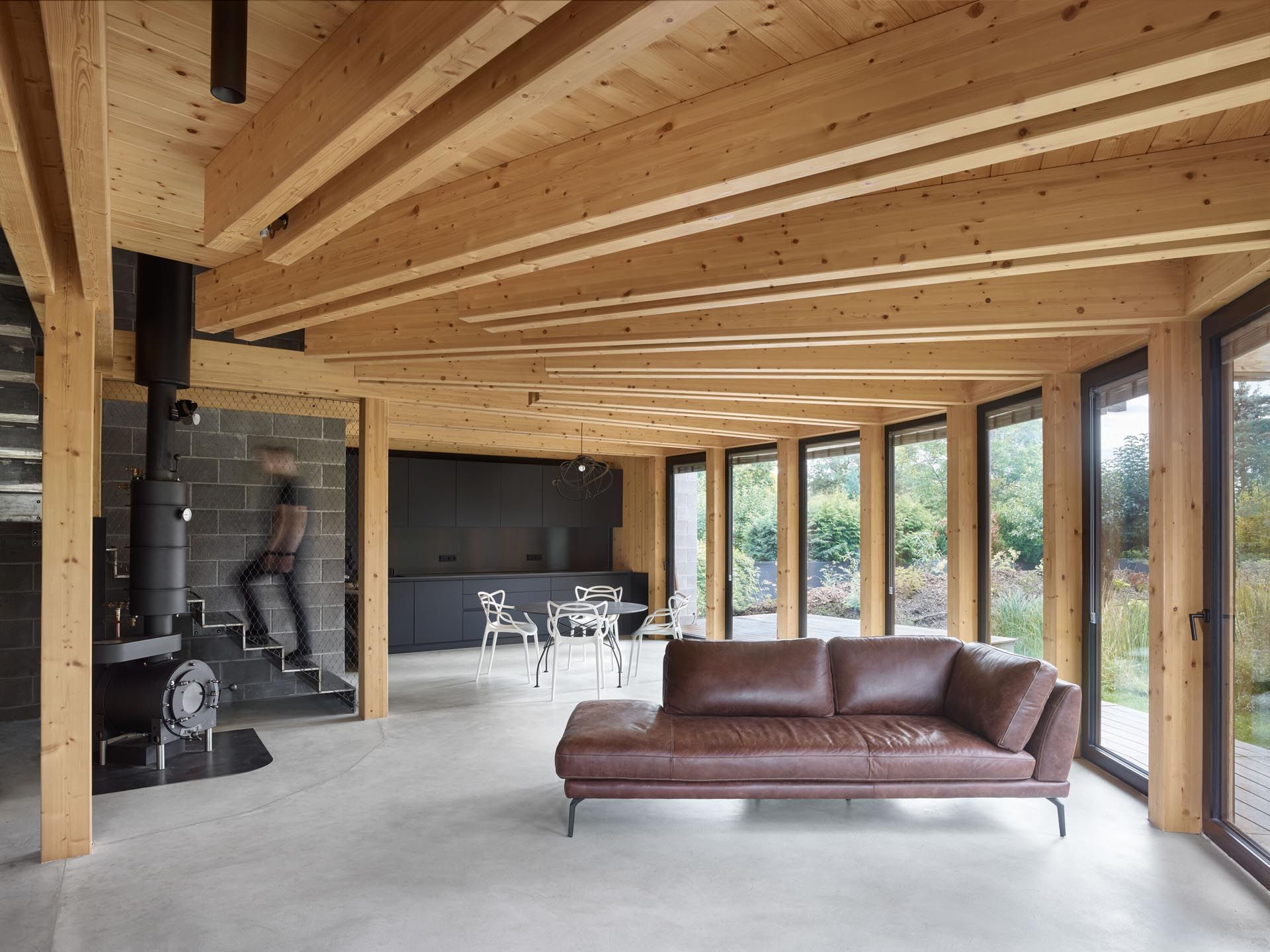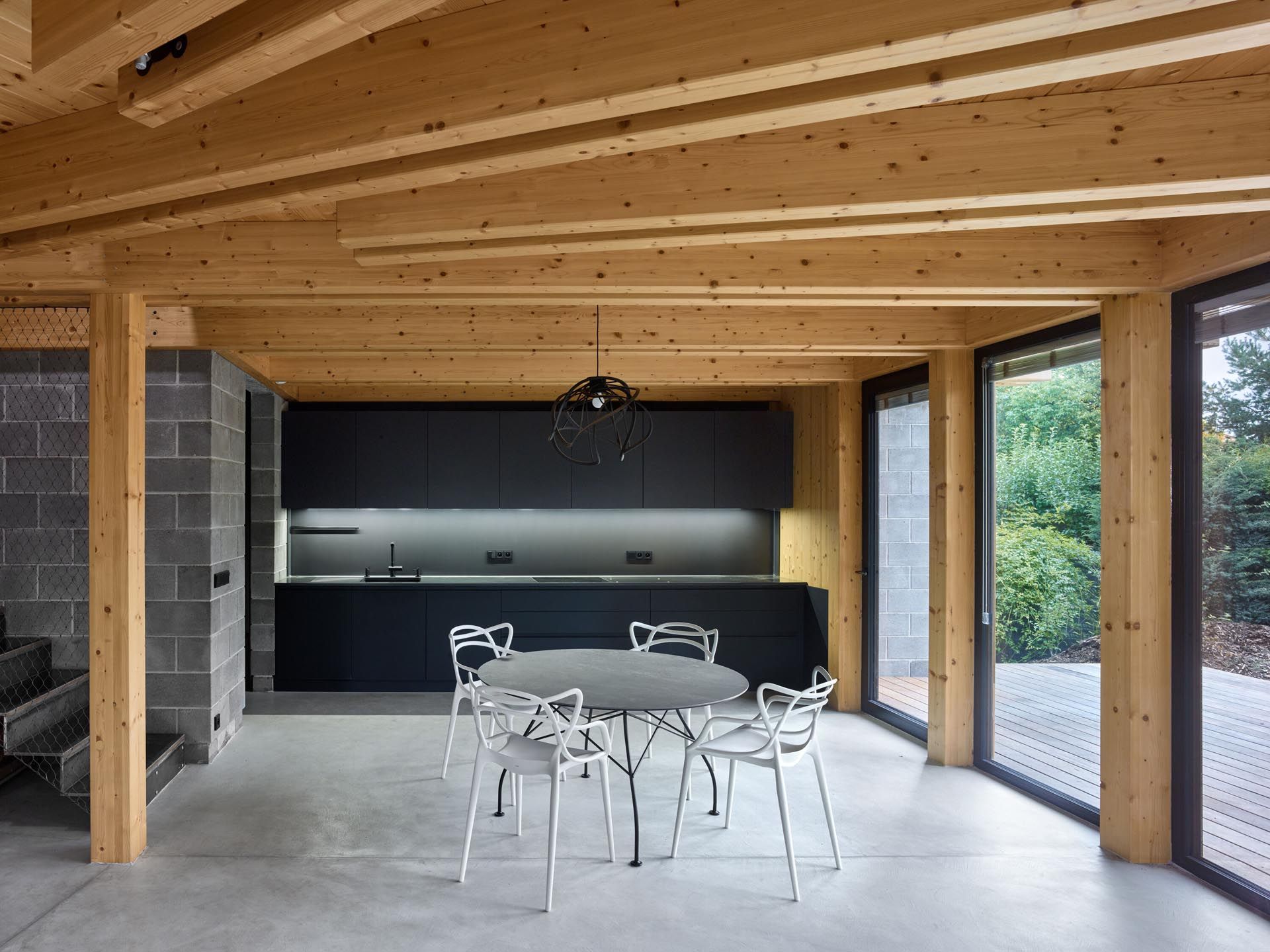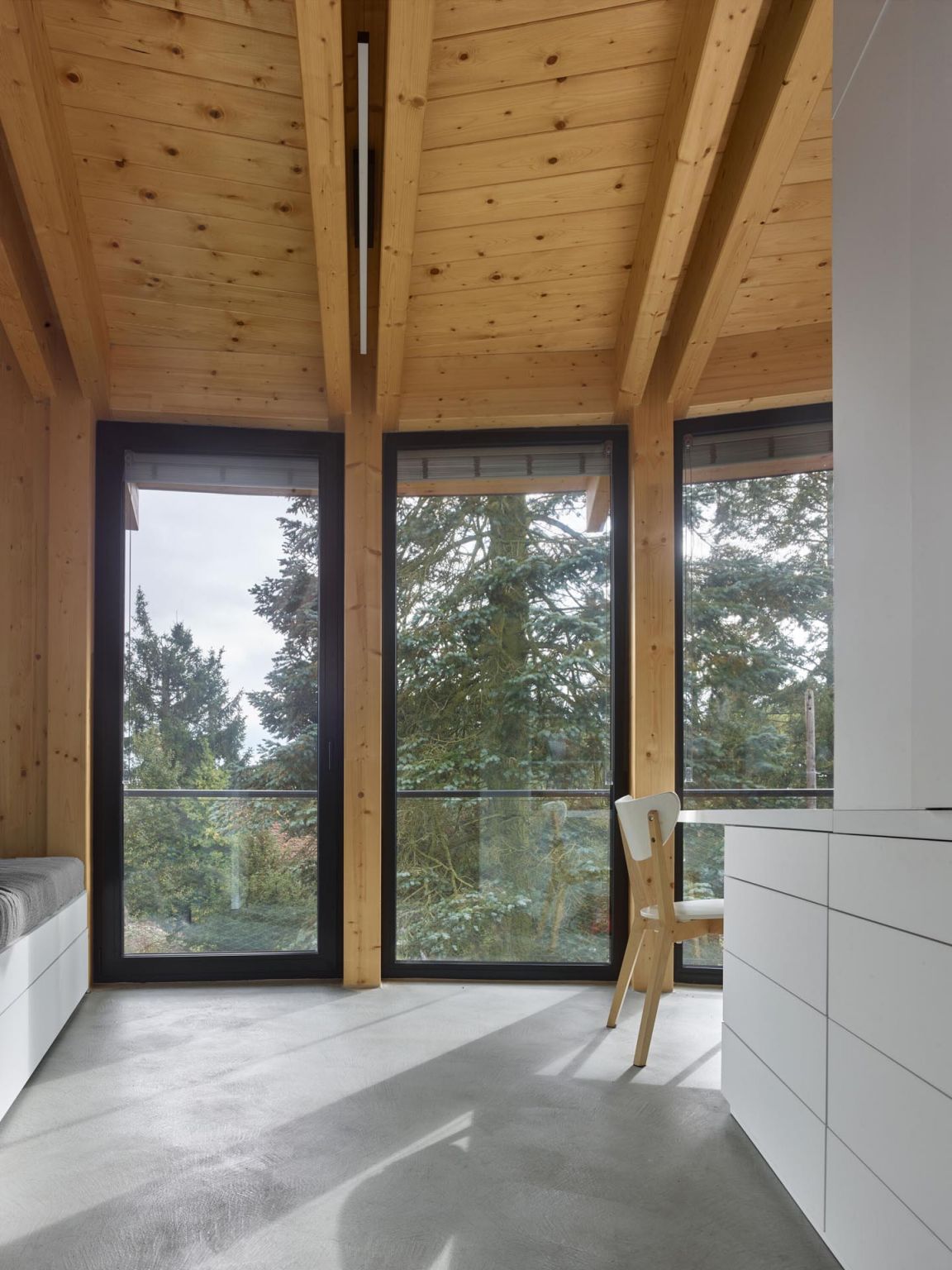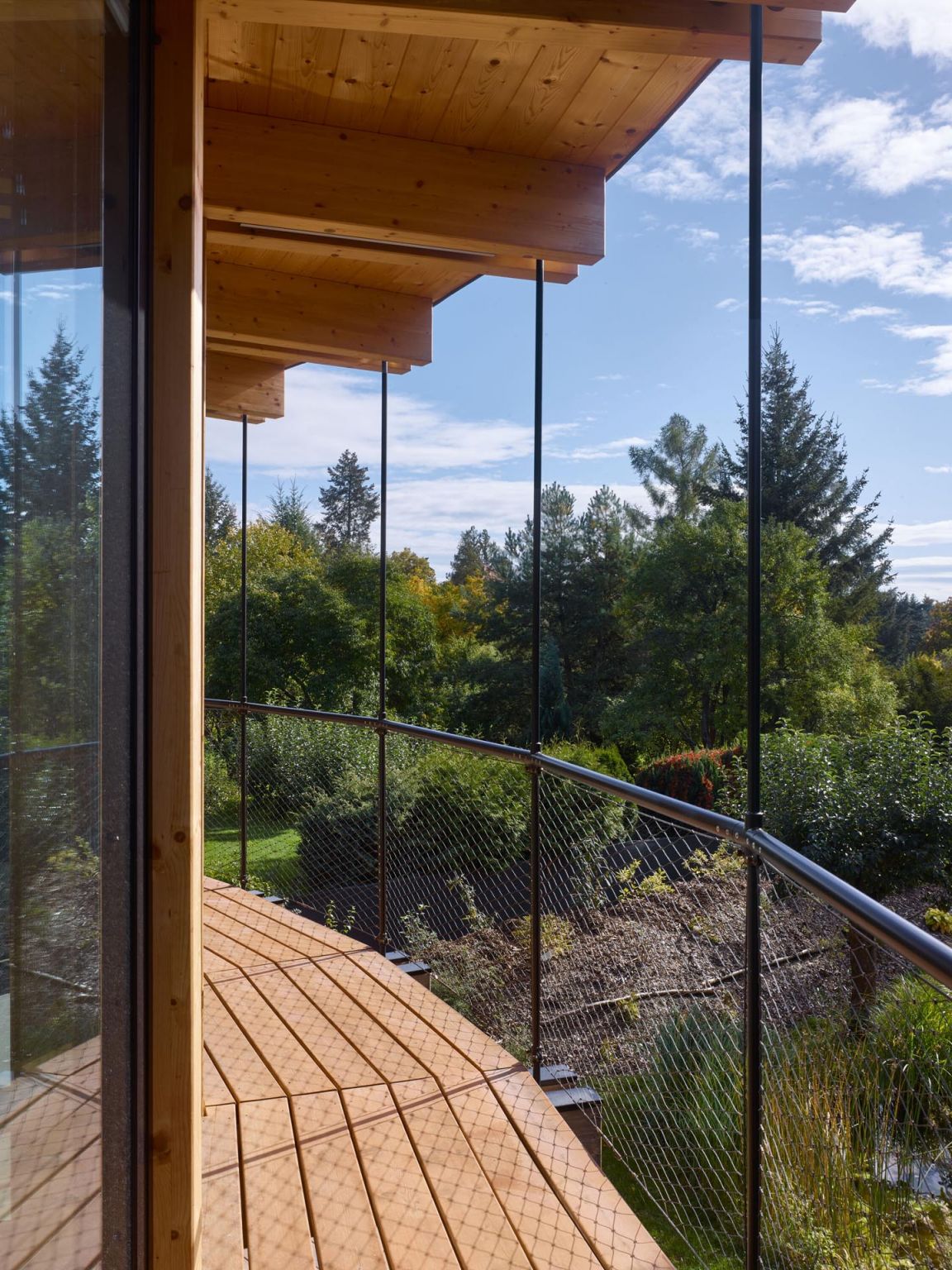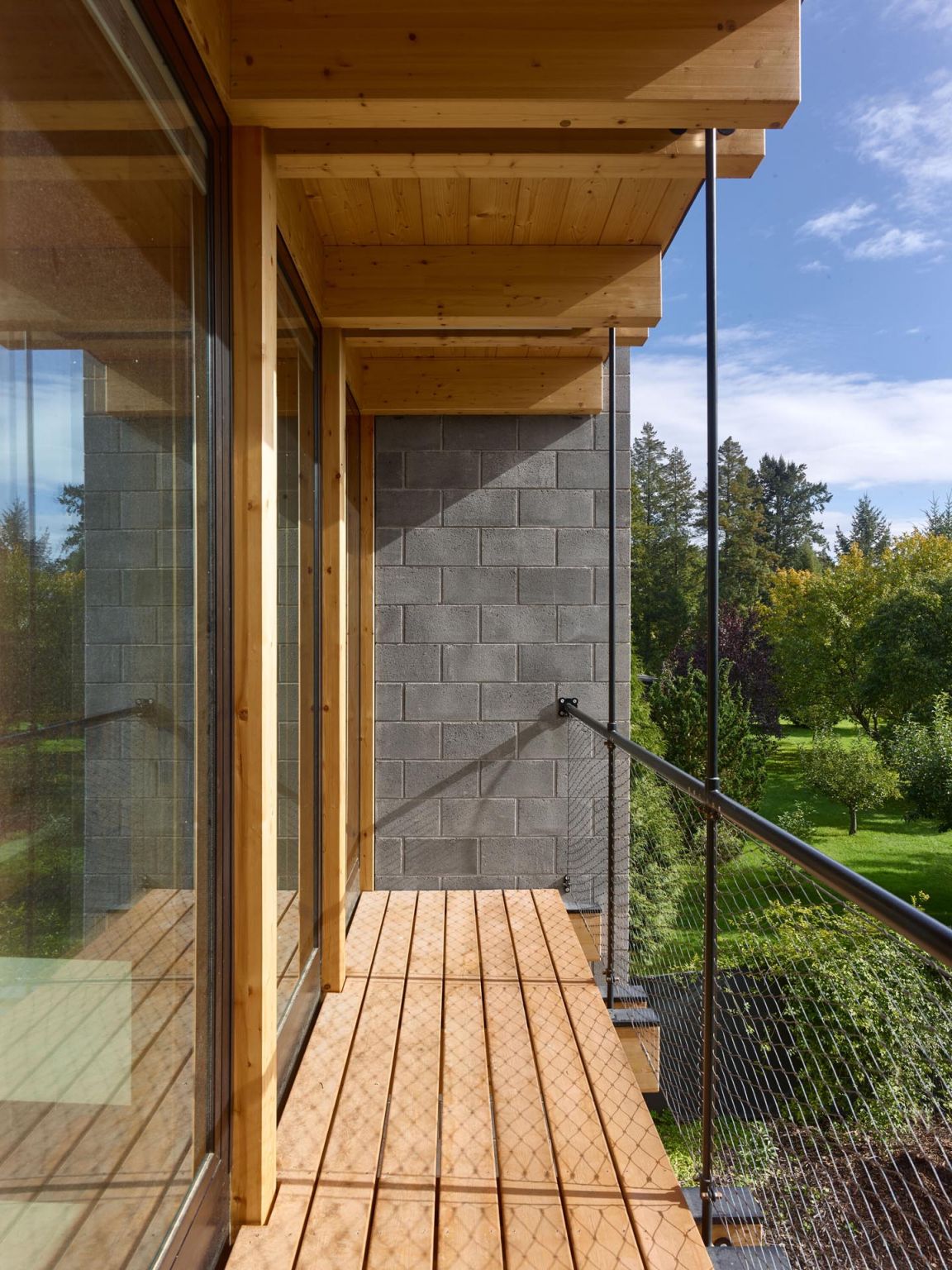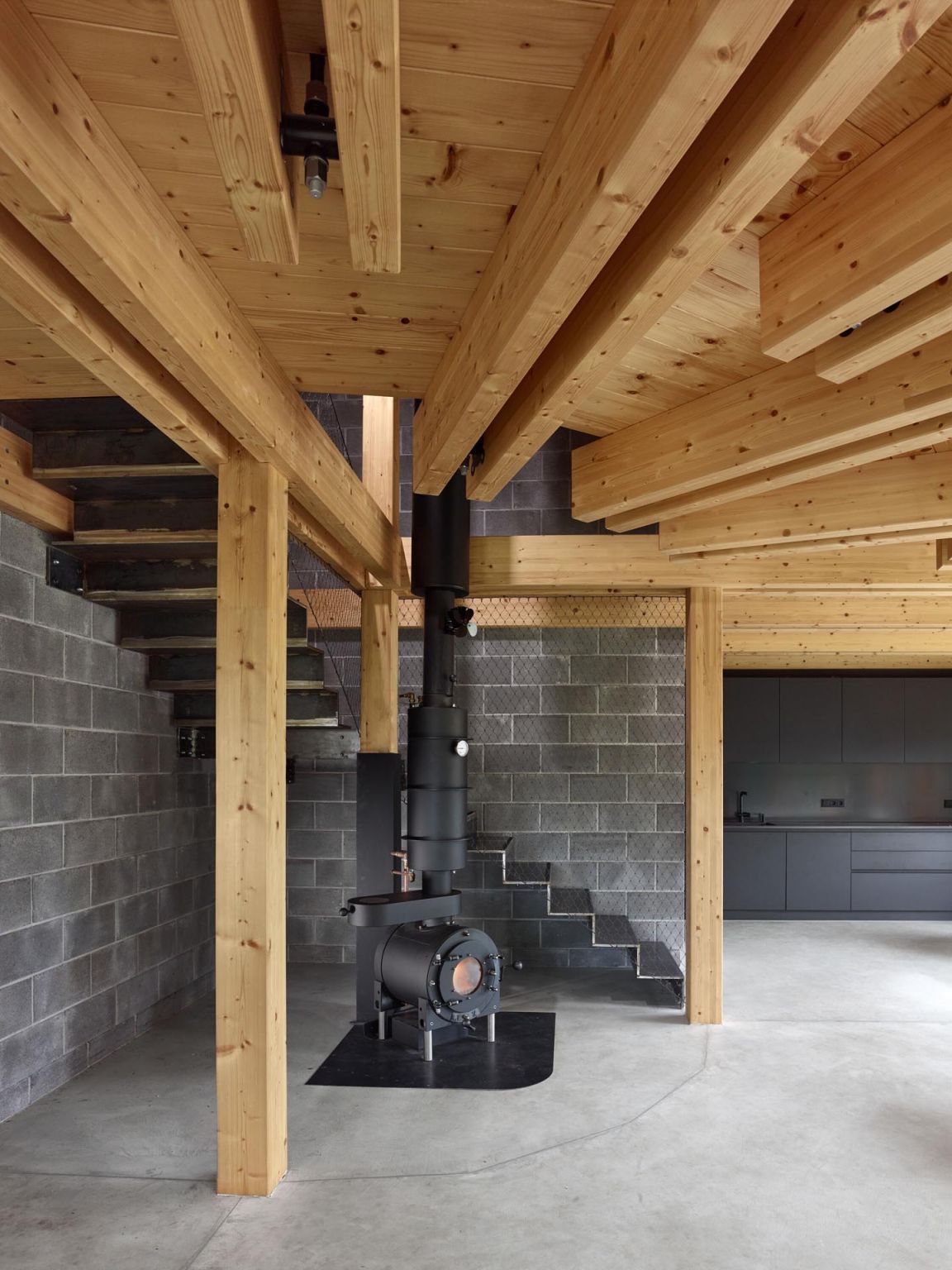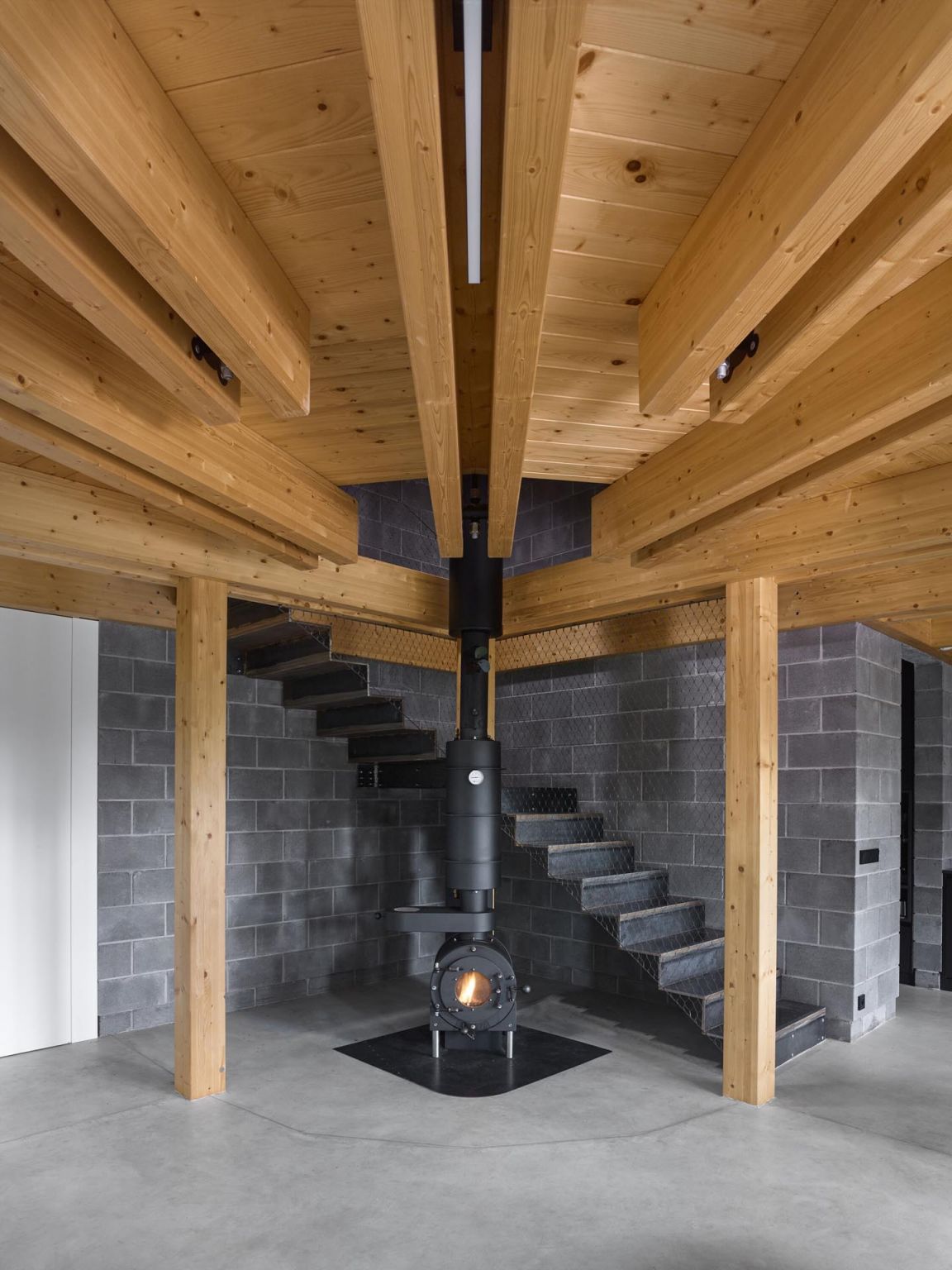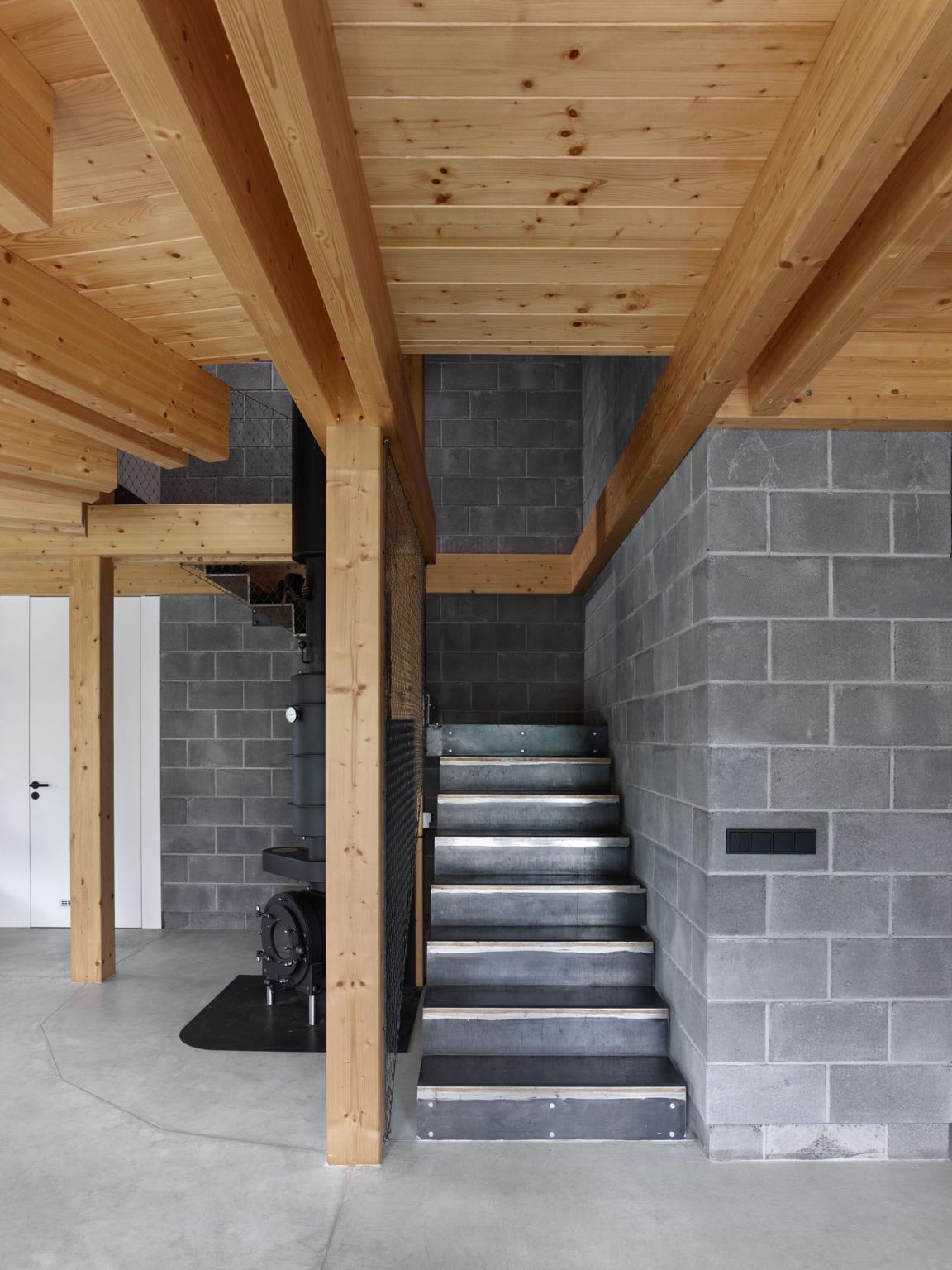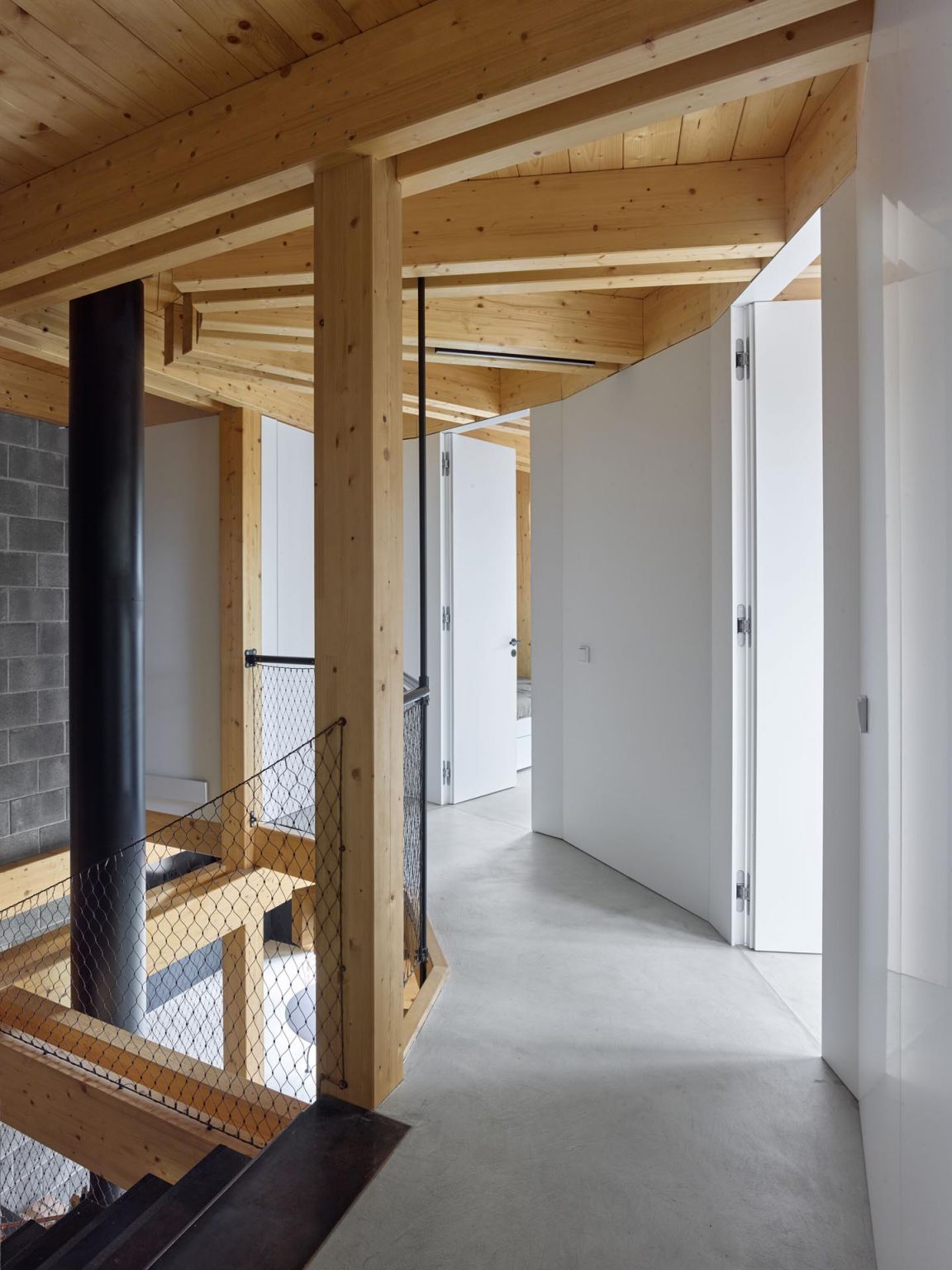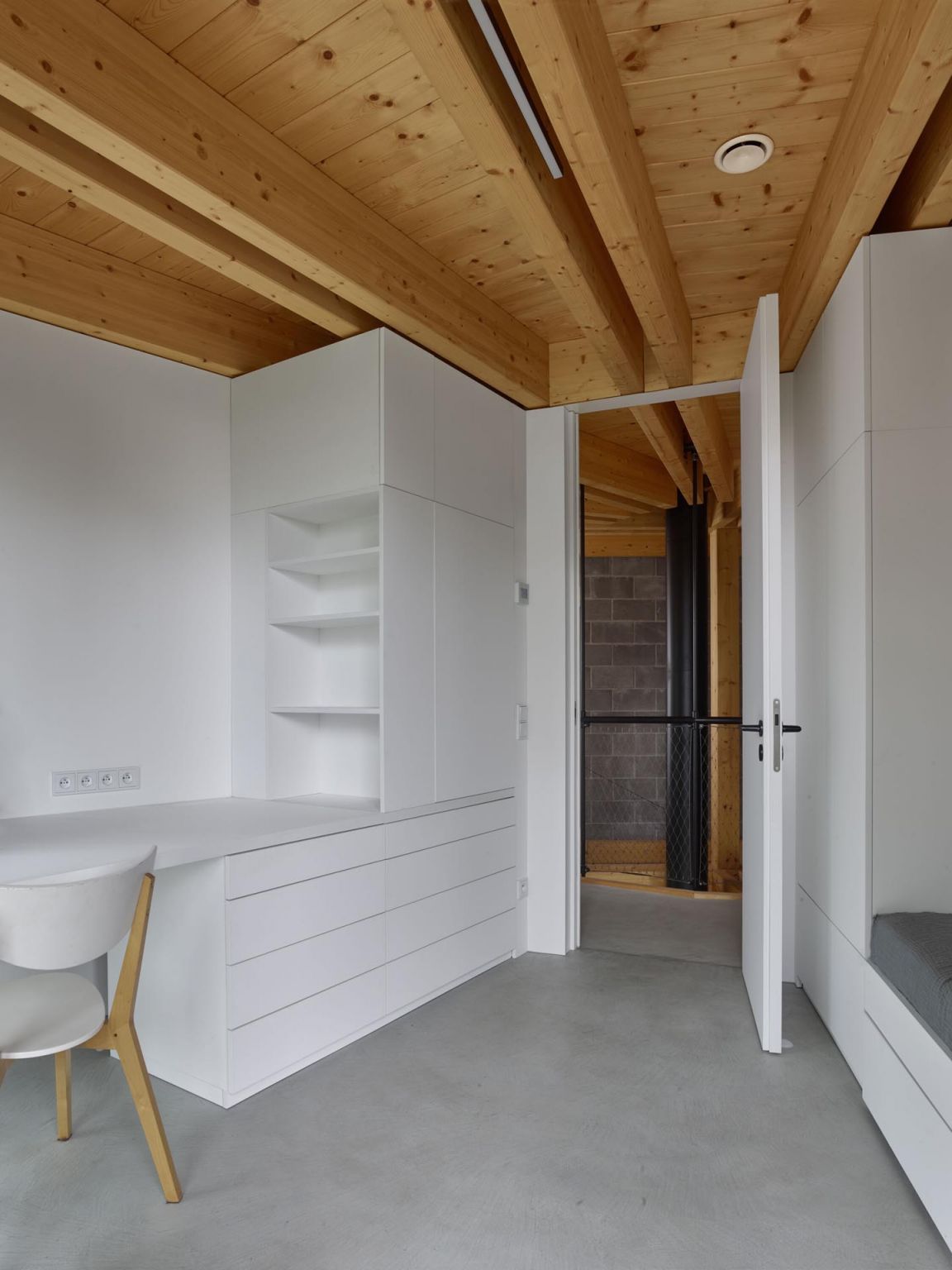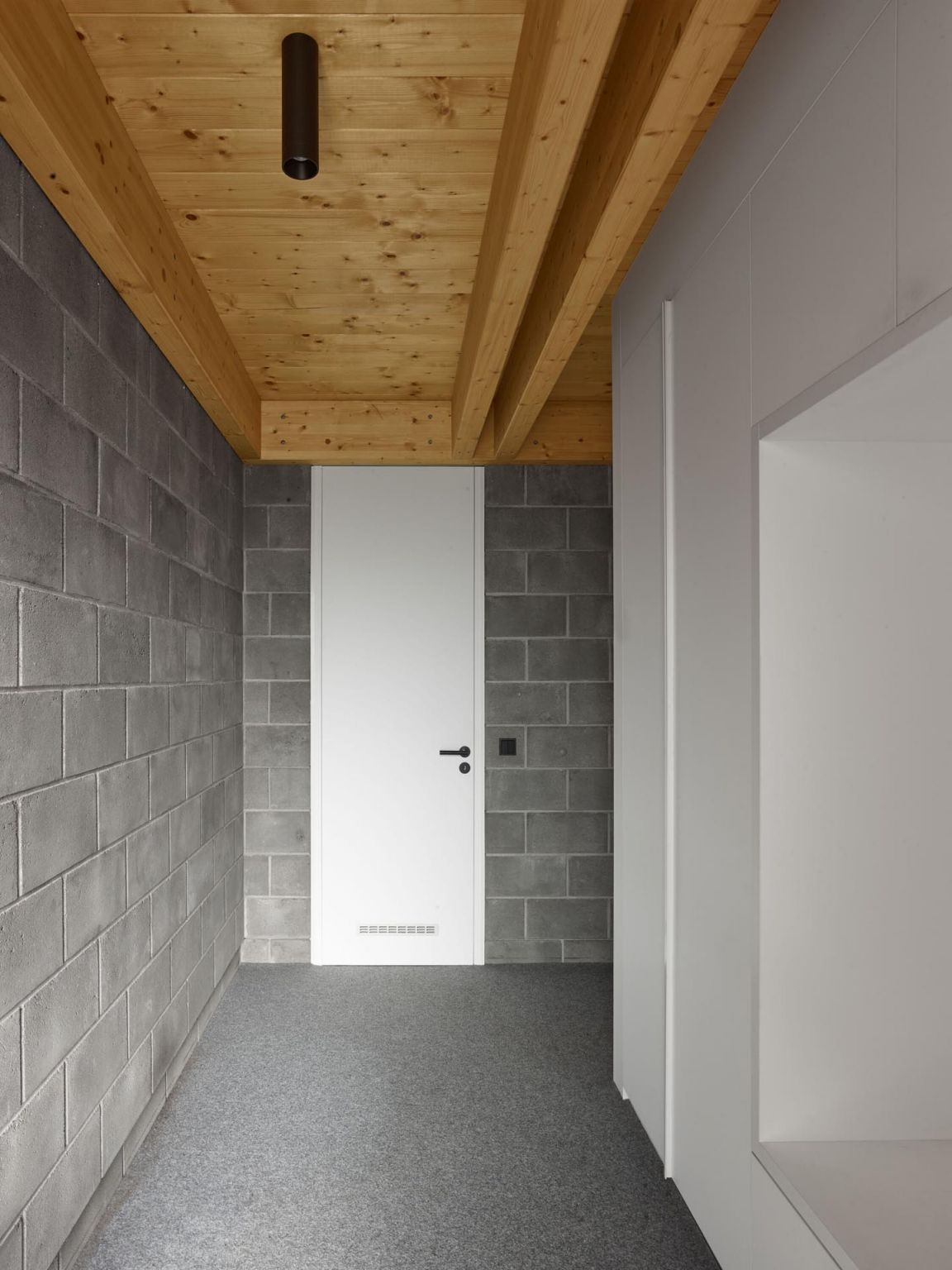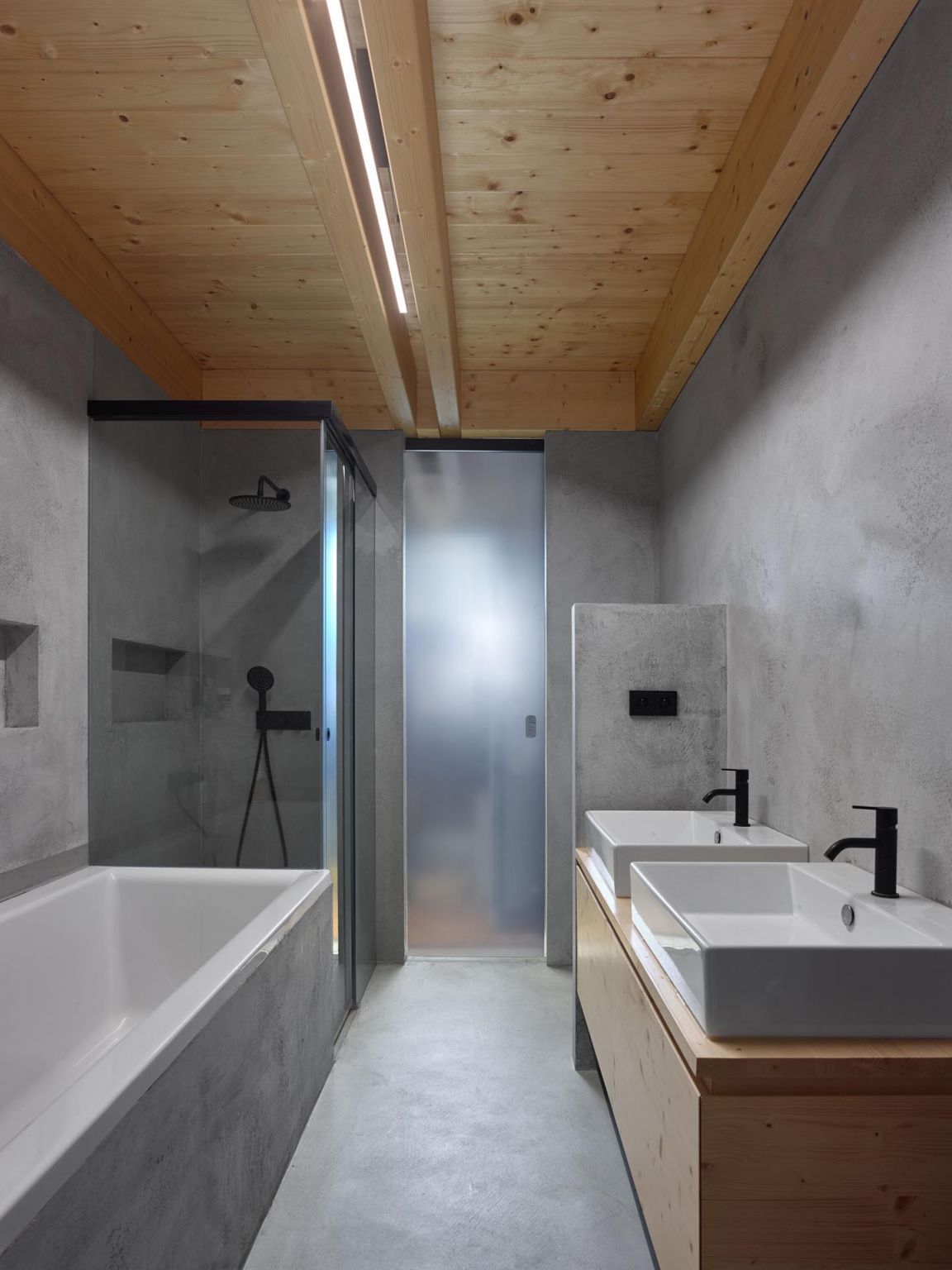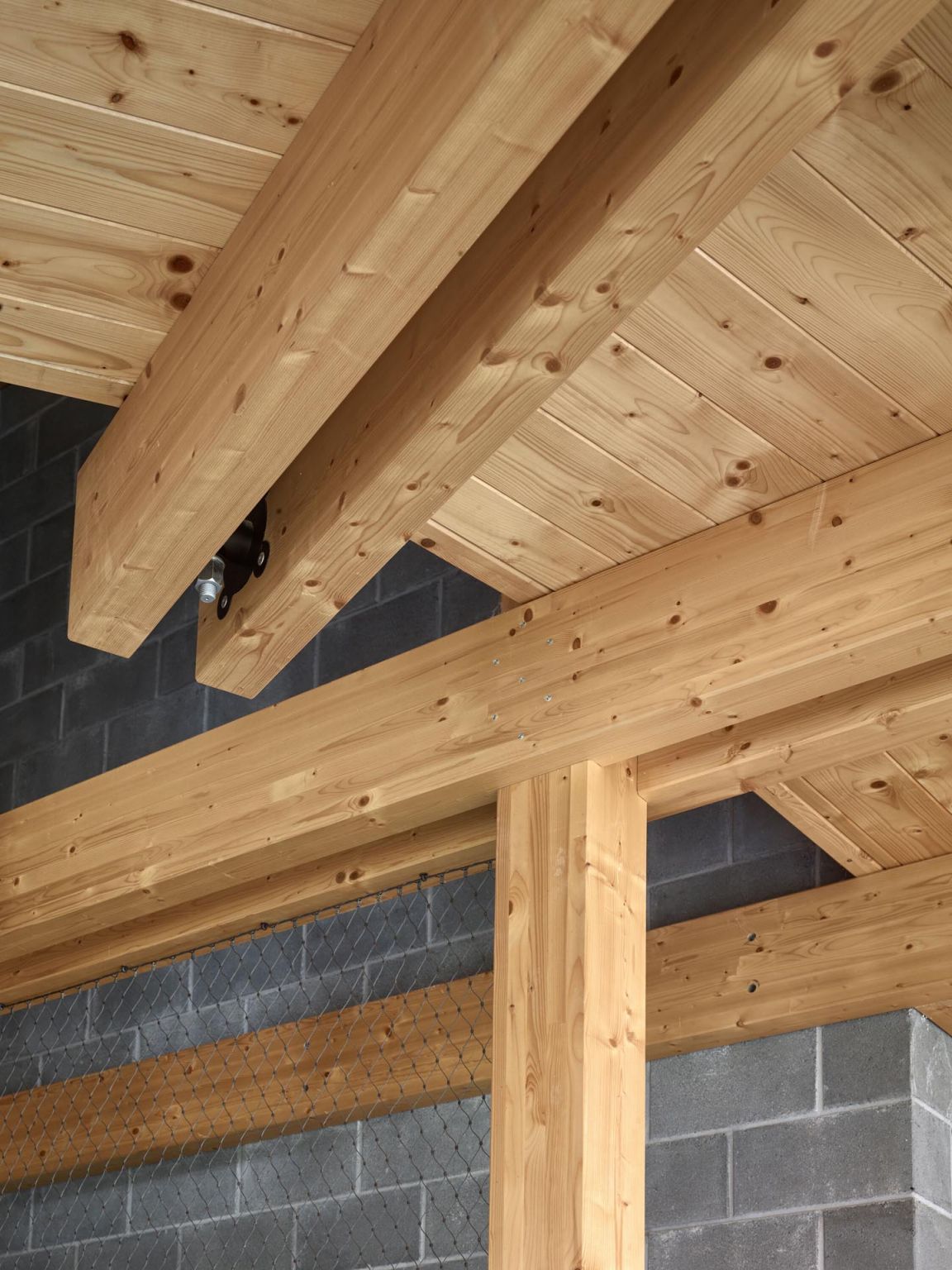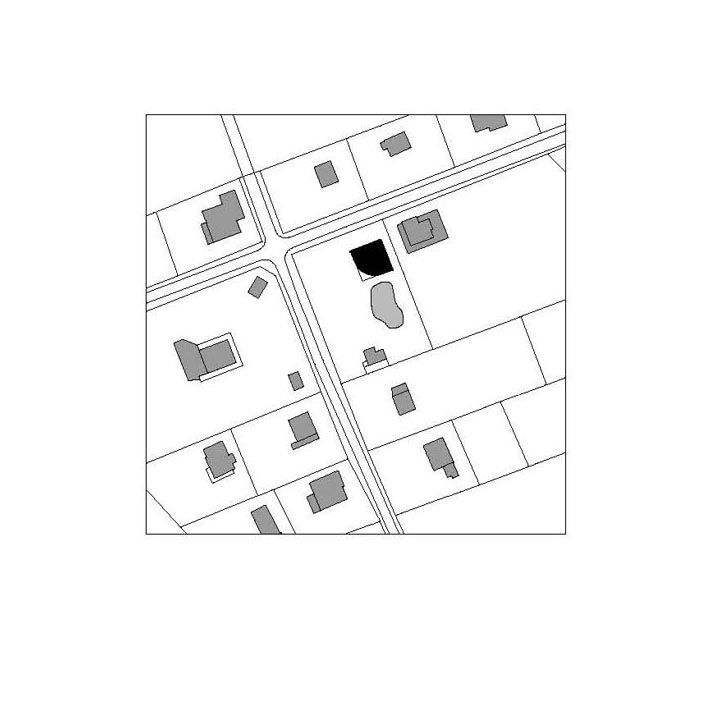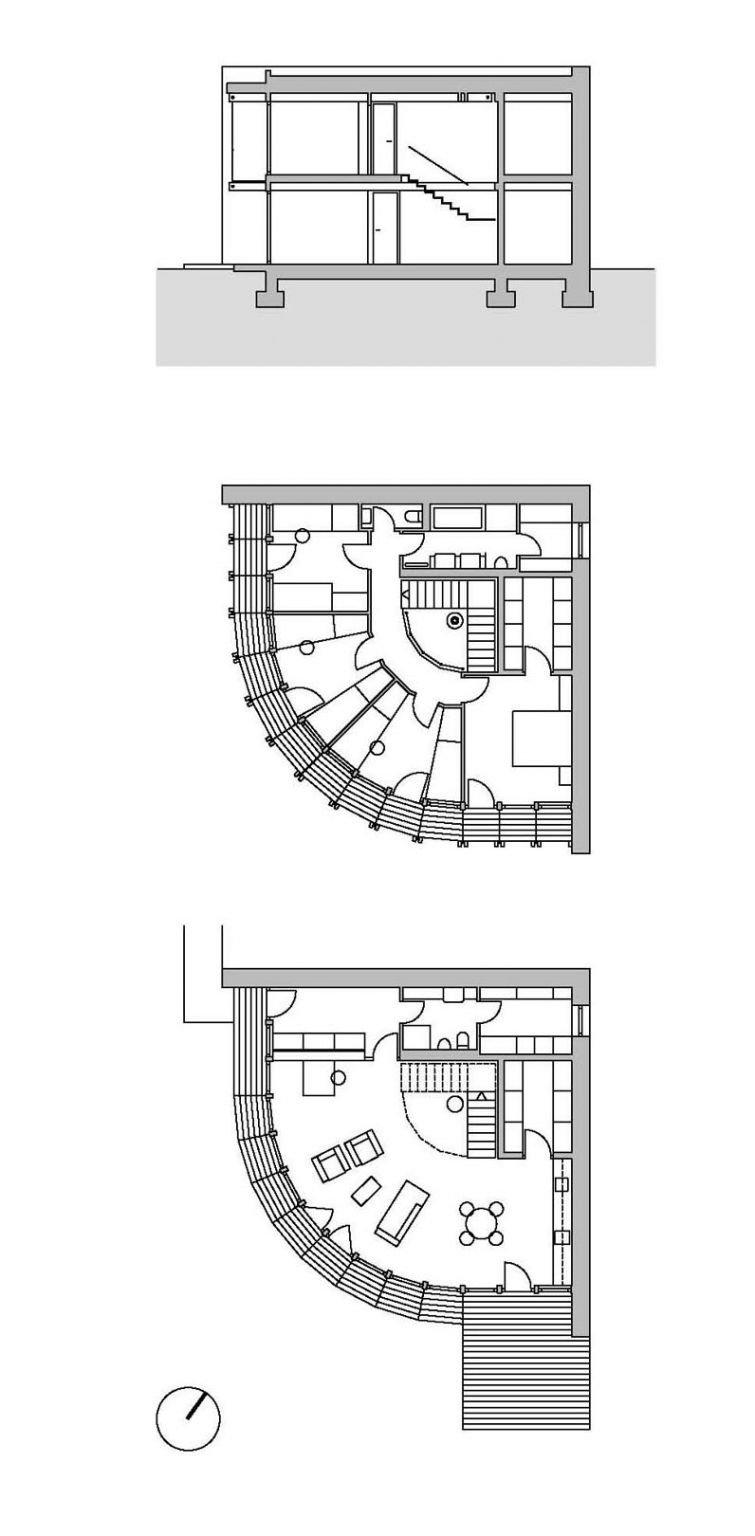描述
In the southern part of Malé Kyšice town on the edge of the Křivoklát woods, there is a residential district originally home to weekend cottages. One such cottage on a flat plot of land was replaced by a passive home. The floor plan closely resembles a quarter-circle with walls made of exposed concrete blocks. The rounded wall and the ceilings are made of wood. The building opens up to the southwest into a fully grown garden. The fully glazed facade consists of windows set in anthracite frames, which are shaded by blinds inside the triple-glazed windows. The ceiling beams extend to cover the balcony on the upper floor and the terrace on the ground floor. The architects made extensive use of the contrast between the concrete and wooden building elements in the interior as well. The ground floor is home to a living room, kitchen, and dining room, and an open staircase leads to the four bedrooms upstairs. The bathrooms, service rooms, and storage spaces are located along the concrete walls.
在Malé kybice镇的南部Křivoklát森林的边缘,有一个原本是周末别墅的住宅区。在一片平坦的土地上,有一间这样的小屋被一栋被动住宅所取代。平面图非常类似于四分之一圆,墙壁由暴露的混凝土块制成。圆形的墙壁和天花板是木制的。建筑向西南方向开放,进入一个成熟的花园。全玻璃立面由无烟煤框架的窗户组成,由三层玻璃窗户内的百叶窗遮挡。天花板横梁延伸覆盖了上层的阳台和底层的露台。建筑师在室内也大量使用了混凝土和木制建筑元素之间的对比。一楼是客厅、厨房和餐厅,开放式楼梯通往楼上的四间卧室。浴室、服务室和存储空间沿着混凝土墙布置。
House that opens up to the sun
向阳光敞开的房子
The building’s story began to be written before the world was paralyzed by the pandemic and before Europe was gripped by an energy crisis. Did the owners’ sixth sense motivate the family to acquire a low-cost house surrounded by a beautiful garden? Not at all: it was their natural and responsible approach to life and their respect for nature, which must be protected. The principles applied during construction will continue to be relevant even after we overcome today’s pressing issues, when we all accept the threat of climate disaster, which we have perhaps ignored too much in the face of the uncertainties of the past few years.
这座建筑的故事开始于世界因大流行而瘫痪之前,在欧洲陷入能源危机之前。是业主的第六感促使这家人买下了一所环绕着美丽花园的低成本房子吗?完全不是:这是他们对生活的自然和负责任的态度,以及他们对自然的尊重,这必须得到保护。即使在我们克服了今天的紧迫问题之后,当我们都接受气候灾难的威胁时,在过去几年的不确定性面前,我们可能忽略了太多,在建设过程中应用的原则将继续适用。
Light and warmth, earth, and last but not least water. The client’s demands – or rather, their way of life – infuse every detail of this house located on the edge of the town of Malé Kyšice near the Křivoklát woods.
光和温暖,泥土,还有水。客户的要求——或者说是他们的生活方式——融入了这座房子的每一个细节,它位于Malé kysice镇的边缘,靠近Křivoklát森林。
Light and warmth
光和温暖
The building opens up to the sun’s rays like a fan, soaking up its energy and seeking to use it economically. Thanks to its shape, the interior welcomes the first as well as the last rays of sunlight. But the house also knows how to keep from overheating, thanks to an overhanging roof and horizontal shading that protects the windows from the midday sun in the summer and acts as a balcony on the upper floor. In addition to the building’s pragmatic shape and passive shading, comfort on summer days is also aided by blinds built into the triple-glazed windows. Thanks to quality workmanship and the use of modern technologies, their effectiveness is comparable to outdoor blinds.
这座建筑像风扇一样向阳光敞开,吸收能量并寻求经济利用。由于它的形状,内部迎接第一缕和最后一缕阳光。但这所房子也知道如何防止过热,这要归功于悬挑的屋顶和水平遮阳板,它可以保护窗户免受夏季正午阳光的照射,并充当上层的阳台。除了建筑的实用造型和被动遮阳外,三层玻璃窗内的百叶窗也有助于夏季的舒适。由于优质的工艺和现代技术的使用,其效果可与室外百叶窗媲美。
Naturally, the homeowners appreciate warmth in the winter, when warmth gathered from the sun reduces heating costs. The building’s self-sufficiency is further aided by a stove with a heat exchanger at the heart of the building. A stairway winding its way around the stove leads up to the bedrooms located above the living room.
自然,房主们喜欢冬天的温暖,因为从太阳收集的温暖可以降低供暖成本。该建筑的自给自足进一步得益于位于建筑中心的带有热交换器的炉子。一条围绕火炉蜿蜒的楼梯通向客厅上方的卧室。
Earth
泥土
The house is built primarily from a renewable material – wood. The building’s construction respects its shape and reveals the constructional principles literally to the last detail, including steel joints and tie rods that add a finishing touch to the interior and exterior. The built-in furniture has been placed between the beams in such a manner that the rooms resemble ship cabins.
这座房子主要由可再生材料——木材建造。建筑的结构尊重其形状,并从字面上揭示了建筑原则,包括钢接头和拉杆,为内部和外部增添了点睛之笔。内置家具被放置在横梁之间,使得房间类似于船舱。
Other important elements of a sustainable approach are durability and lifespan. For this reason, the building’s windward sides are protected by walls made of concrete blocks. An insulated sandwich wall aids in the natural accumulation of warmth while also promoting the building’s stability. All technical rooms and bathrooms are concentrated along these solid, stable walls to create something like a zone of balance between the building’s southern and northern sides.
可持续方法的其他重要因素是耐久性和寿命。因此,建筑物的迎风面由混凝土砌块制成的墙保护。隔热夹层墙有助于自然积聚热量,同时也促进了建筑的稳定性。所有技术室和浴室都集中在这些坚固、稳定的墙壁上,以在建筑的南部和北部之间形成一个平衡区。
Water and air
水和空气
The way the building uses water is visible at the first glaze. A small pond optimizes the use of rainwater, meaning there is sufficient water for watering the garden even during dry periods, thanks also to its own root zone treatment plant.
建筑用水的方式在第一次上釉时就可以看到。一个小池塘优化了雨水的利用,这意味着即使在干旱时期也有足够的水浇灌花园,这也要归功于它自己的根区处理厂。
The retention of surface water in the garden pleasantly influences the microclimate in the immediate vicinity of the building. The property releases no wastewater into the local sewers – all water is used at least twice. The house takes a similar approach to air by using recuperation to warm fresh air from outside during the winter months.
花园中地表水的滞留会对建筑物附近的小气候产生积极的影响。该物业不会向当地下水道排放废水——所有水至少使用两次。在冬天的几个月里,这所房子也采用了类似的方法,通过疗养来温暖室外的新鲜空气。
The owners moved into the building even before it was completely finished. Over time, they have made not only the house but also the garden their home. Buried under the garden is a prefabricated cellar made of recycled plastic. Gardening implements and bicycles are stored in shipping containers. The house lives its own, undemanding life and is gradually blending in with the garden.
业主甚至在大楼完全完工之前就搬进了大楼。随着时间的推移,他们不仅把房子当成了家,还把花园当成了家。花园下面埋着一个由再生塑料制成的预制地窖。园艺用具和自行车存放在运输集装箱中。这所房子过着自己的生活,并不苛求,并逐渐与花园融为一体。


